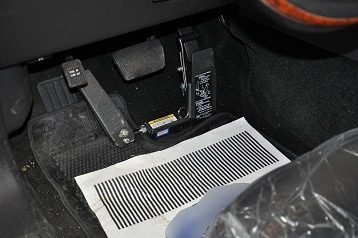NIOSH-Funded State FACE Investigation Leads to Safer Handicapped-Accessible Accelerator Pedals
June 2015
DHHS (NIOSH) Publication Number 2015-186
A Story of Impact:

Photo of handicapped-accessible brake and accelerator pedals. Photo courtesy of Kentucky OSHA.
In 2012, over 157,000 establishments employed 833,919 automotive technicians in the U.S.1 Auto technicians play an important role in ensuring the safety of our cars. However, technicians encounter a number of dangers in their workplace when dealing with passenger vehicles that range in weight from about 2,200 to 3,300 lbs., depending upon the make and model.2 Nationally, there were 71 fatal injuries reported in the automotive repair and maintenance industry in 2012.3 The Kentucky (KY) Fatality Assessment and Control Evaluation (KY FACE) program—funded by the National Institute for Occupational Safety and Health (NIOSH)—investigated a death of a 50-year-old certified master technician who was struck by a car while sitting at a desk in a dealership’s service bay.
An auto technician working in the service bay was preparing a vehicle for an oil change when he mistook a handicapped-accessible accelerator pedal for the brake pedal. The handicapped-accessible pedal, which can be removed, had a left foot accelerator made for individuals who have lost the ability to use their right foot. Mistaking the accelerator pedal for the brake pedal caused the vehicle to strike the victim from behind and pin him against his desk and a wall causing blunt force injuries. After calling 911, an employee with emergency medical technician experience, rushed to the scene, assessed the situation, and covered him to prevent shock until emergency responders arrived. On the way to the hospital, the victim suffered cardiac arrest and died from his injuries.
The KY FACE program investigator evaluated the incident and produced the report “Auto Technician Mistakes Handicapped Accessible Accelerator Pedal for Brake Pedal and Fatally Pins Co-Worker”.4 The report identified two key recommendations to prevent future incidents from occurring: (1) removal of handicapped-accessible equipment prior to operation; and (2) moving office spaces away from car servicing areas.
The FACE report was emailed to 45 car dealerships in Kentucky and 11 handicapped-accessible gas pedal manufacturers. Based on the report, Veigel North America LLC Mobility Products & Design redesigned their Left Foot Accelerator, Model 3545, to retrofit a vehicle’s steering column with a key switch. When starting a vehicle with the redesigned pedal, the system defaults to a standard, factory pedal. To activate the left accelerator pedal, a driver must turn the key switch on and press the accelerator function switch to the left. This modification eliminates the need to remove the pedal for servicing and prevents unintended drivers from using the left foot accelerator.5 The redesigned pedal was introduced at the National Mobility Equipment Dealers Conference in February 2015 and is anticipated to be available to the public in June 2015.
Beyond Veigel’s modification to the handicapped-accessible pedal, the car dealership where the incident occurred established new employee policies based on the FACE report recommendations. The new policies require employees to remove all accessibility equipment on vehicles before any work is started and perform all administrative duties in an area away from the service area. Taken together, the redesign of the handicapped-accessible gas pedal and establishment of employee policies will aid in the safety of auto technicians.
Mention of company names or products does not imply endorsement by the National Institute for Occupational Safety and Health.
- Handicapped-accessible equipment should be removed by auto service technicians before operating the vehicle.
- Administrative duties and office space should be performed in an area away from the path of vehicles being serviced.
- Employee training and written employer policies about handicapped-accessible equipment removal could prevent future fatalities.
View/Download Entire Document: NIOSH-Funded State FACE Investigation Leads to Safer Handicapped-Accessible Accelerator Pedals [PDF – 491K]
![]()
![]()

![]()
For more information about the National Institute for Occupational Safety and Health (NIOSH) FACE program, visit www.cdc.gov/niosh/face, or the KY FACE program visit www.mc.uky.edu/kiprc/projects/KOSHS/index.html.
References
- U.S. Census Bureau [2012]. Automotive repair and maintenance (NAICS 8111). Industry snapshot. [http://thedataweb.rm.census.gov/TheDataWeb_HotReport2/econsnapshot/2012/snapshot.hrml?NAICS=8111].
- MacKenzie D, Zoepf S, Heywood J [2014]. Determinants of US passenger car weight. International Journal of Vehicle Design, 65(1): 73–93.
- BLS[2012]. Fatal occupational injuries by industry and event or exposure, all U.S., 2012. Bureau of Labor Statistics [http://www.bls.gov/iif/oshwc/cfoi/cftb0268.pdf].
- NIOSH [2014]. Auto technician mistakes handicapped-accessible accelerator pedal for brake pedal and fatally pins co-worker. Kentucky Fatality Assessment and Control Evaluation Program, Kentucky Injury Prevention Research Center, National Occupational Institute for Occupational Safety and Health, Centers for Disease Control and Prevention, U.S. Department of Health and Human Services. Kentucky Report 14KY001. [https://www.cdc.gov/niosh/face/pdfs/14KY001.pdf]. Date accessed: March 2015.
- Veigel [2015]. Veigel electronic left foot accelerator brochure.
